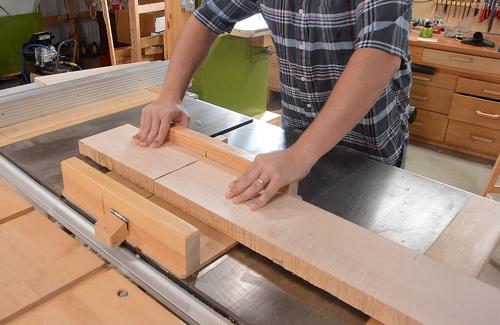 While building a cajon with Paul, I let him do much
of the work. I got to see some beginner mistakes that I don't normally think about,
but are worth covering.
While building a cajon with Paul, I let him do much
of the work. I got to see some beginner mistakes that I don't normally think about,
but are worth covering.
 While building a cajon with Paul, I let him do much
of the work. I got to see some beginner mistakes that I don't normally think about,
but are worth covering.
While building a cajon with Paul, I let him do much
of the work. I got to see some beginner mistakes that I don't normally think about,
but are worth covering.
The first mistake was pinching the blade. We used my small table saw sled to cut a piece of wood. Once the cut was nearly through, the weight of the wood hanging off to Paul's left caused it to lift up in the middle, and the small amount of wood remaining above the blade just bent. But that caused the cut ends of the board to fold together onto the blade, pinching it and stalling the blade. I ran for the switch to shut it off.
If it was me making the cut, I would have held down the wood near the blade.
Using a wider table saw sled, or using a miter saw would have prevented this problem.
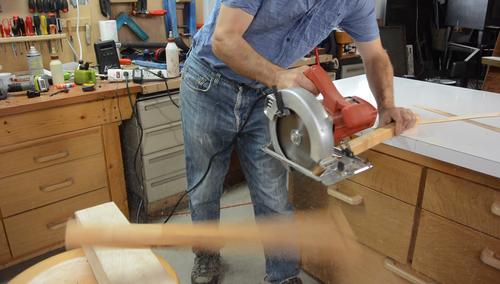 Blade pinching is more commonly experienced with hand held circular
saws. If the wood is supported only far away from the saw, as shown here.
As I was finishing the cut, it bent and pinched the blade. This being a small
piece of wood, once it pinched, the saw grabbed and shot it forward, tearing
the rest of the wood at the same time.
Blade pinching is more commonly experienced with hand held circular
saws. If the wood is supported only far away from the saw, as shown here.
As I was finishing the cut, it bent and pinched the blade. This being a small
piece of wood, once it pinched, the saw grabbed and shot it forward, tearing
the rest of the wood at the same time.
This is more dangerous with bigger pieces of wood, which tend to cause the saw to push itself back out of the cut. Coming backward out of the cut, the saw's blade guard will still be retracted so it could potentially cut your leg.
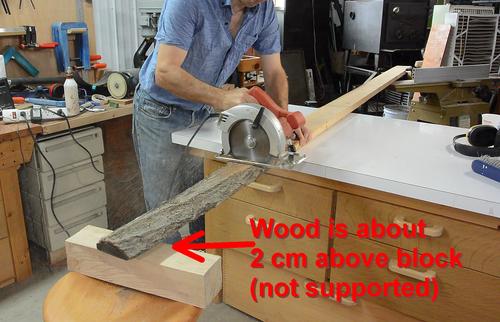 The way to avoid this problem is to make sure the wood is supported near the saw.
If the cutoff is short, it's easiest to just leave it unsupported. For longer heavier
cutoffs, you may want a support to catch it, but the support should be a bit
lower than the piece of wood is (the wood is not resting on the support before
you start the cut).
The way to avoid this problem is to make sure the wood is supported near the saw.
If the cutoff is short, it's easiest to just leave it unsupported. For longer heavier
cutoffs, you may want a support to catch it, but the support should be a bit
lower than the piece of wood is (the wood is not resting on the support before
you start the cut).
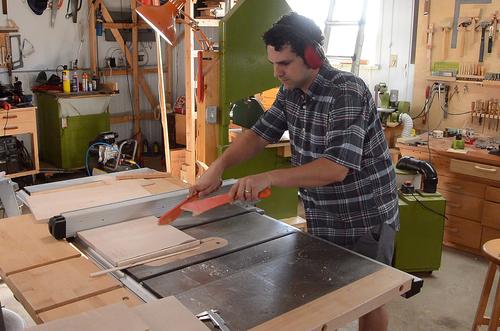 The next mistake was when Paul was ripping a piece of wood to width. As he has seen
me do, he used push sticks.
But being wary of the blade, he's pushing the wood too
far away from the blade with his right hand. Worse yet, he keeps cutting while
NOT using his left hand push stick to keep the wood pushed down and towards
the fence.
The next mistake was when Paul was ripping a piece of wood to width. As he has seen
me do, he used push sticks.
But being wary of the blade, he's pushing the wood too
far away from the blade with his right hand. Worse yet, he keeps cutting while
NOT using his left hand push stick to keep the wood pushed down and towards
the fence.
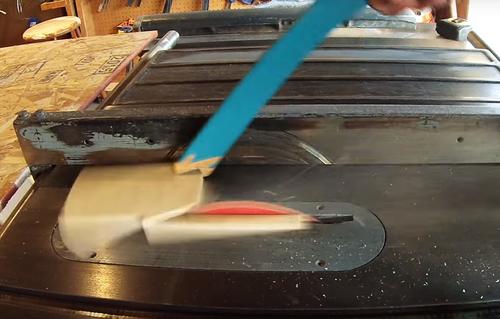 This could have resulted in some nasty kickback, like the one
shown in this video.
The image at left is a still frame from this video, just as the kickback
starts. Note the position of the push stick, and how the piece
is blurred from starting to rotate onto the blade. About a tenth of a second
later, the piece of wood had already hit the operator.
This could have resulted in some nasty kickback, like the one
shown in this video.
The image at left is a still frame from this video, just as the kickback
starts. Note the position of the push stick, and how the piece
is blurred from starting to rotate onto the blade. About a tenth of a second
later, the piece of wood had already hit the operator.
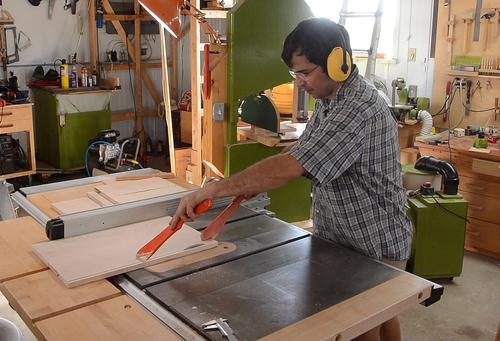 A better technique - push near the blade, and use the other push stick to help push
the wood down and towards the fence.
A better technique - push near the blade, and use the other push stick to help push
the wood down and towards the fence.
John Heisz doesn't like this style of push sticks and is more an advocate of using bare hands for this type of cut. (see his video). I have to say, seeing how Paul cut the panel, he would have been better off using his hands. Though with a smaller panel, and if for some reason kickback were to occur without pushsticks, the risk of getting fingers caught in the blade would be much higher
A table saw with a riving knife will greatly reduce the probability of this type of kickback. But my table saw is not designed to take a riving knife (it's not the sort of thing that can be retrofit). And even if it did, I'm not sure how much I'd use it because I use different sizes and thicknesses of blade, and some of the things I do actually require cutting with the back edge of the blade.
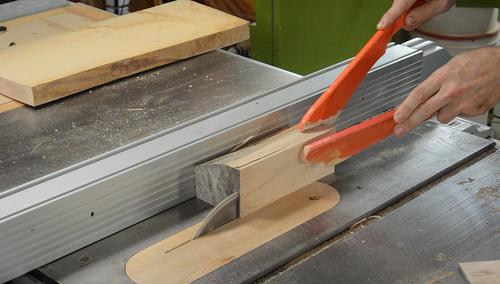 When cutting hardwoods it's not uncommon to get some "burning" where friction
with the blade heats up the wood enough for it to blacken from the heat.
When cutting hardwoods it's not uncommon to get some "burning" where friction
with the blade heats up the wood enough for it to blacken from the heat.
This is more likely to happen with hard woods and if there is pressure against the side of the blade. In fact, burning that you see is always with friction on the side of the blade, because if you were to get burning at the front of the saw's teeth, that always gets cut away, so you wouldn't see it. While cutting the panels, Paul experienced some burning because the way he pushed the wood through, it was pushing against the side of the blade.
Burning often happens if you stop in the middle of the cut and then continue. Also if you cut too slowly. But if cutting a piece of hardwood as thick as the one shown here, my saw is not powerful enough to cut through it fast enough to avoid burning with some hardwoods. So what I do is I cut it at half depth first, then raise the blade and cut again to finish the cut. Demonstrating this, even with adjusting in between, the two cuts took less time than making a single cut at full depth.
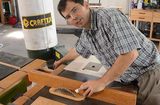 I Cut my finger on the table saw (video only)
I Cut my finger on the table saw (video only)